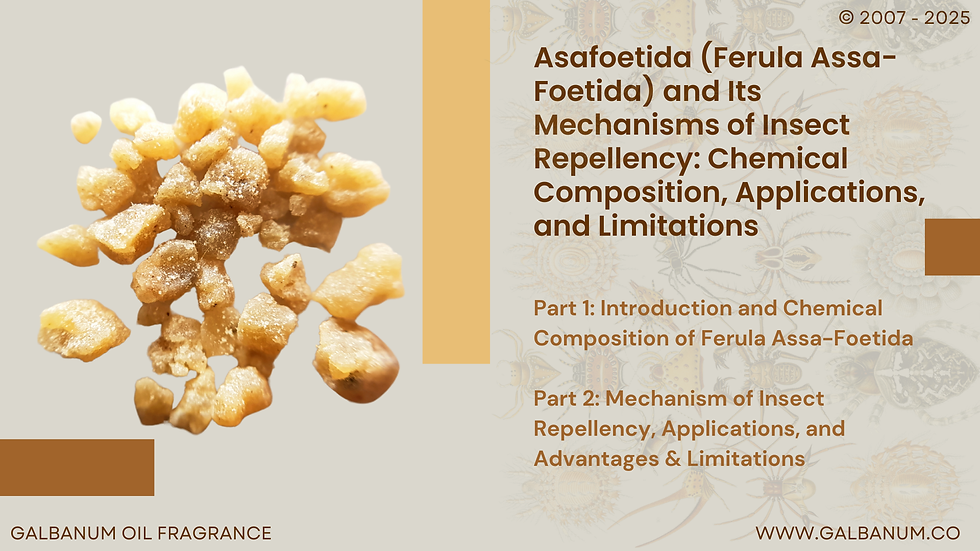Asafoetida (Ferula Assa-Foetida) and Its Mechanisms of Insect Repellency: Chemical Composition, Applications, and Limitations
- Christi Taban

- Oct 3
- 3 min read

Part 1: Introduction and Chemical Composition of Ferula Assa-Foetida
Introduction
Ferula assa-foetida, commonly known as asafoetida, is a perennial herbaceous plant native to the dry and semi-arid regions of the Middle East, including Persia, Afghanistan, and India. Traditionally, asafoetida has been valued for its medicinal properties, such as treating digestive issues, respiratory ailments, and inflammation. In addition to its therapeutic uses, asafoetida is gaining attention as a natural insect repellent, thanks to its potent odor and bioactive chemical compounds.
The demand for natural repellents has grown steadily due to concerns about synthetic pesticides, which can cause environmental harm and pose health risks. In this context, asafoetida offers a promising alternative for organic agriculture, household pest control, and personal protection against insects.
Chemical Composition
The insect-repelling properties of asafoetida are largely attributed to its complex chemical makeup, primarily found in its resin, roots, and gum. Key constituents include:
Sulfur-containing compounds: These are primarily responsible for the pungent, sulfurous odor that insects find repellent.
Ferulic acid and related phenolic compounds: They contribute to the plant’s bioactivity, including antimicrobial and insect-repellent effects.
Monoterpenes and sesquiterpenes: These volatile compounds enhance the deterrent effect by disrupting insect olfactory mechanisms.
Other minor constituents: Alkaloids, coumarins, and resinous compounds add to the overall potency and bioactivity.
Scientific studies suggest that these compounds interfere with insects’ chemoreceptors, affecting feeding, oviposition, and overall survival. Asafoetida essential oil, for example, has shown the ability to repel mosquitoes, cockroaches, and crop pests by creating an environment they find unfavorable.

Part 2: Mechanism of Insect Repellency, Applications, and Advantages & Limitations
Mechanism of Insect Repellency
The insect-repelling activity of asafoetida can be explained through several mechanisms:
Effect on Insect Olfaction: The sulfurous odor overwhelms insects’ olfactory system, preventing them from detecting food or suitable habitats.
Mild Toxic Effects: Certain bioactive compounds can reduce insect activity, cause temporary paralysis, or even lead to mortality in small insects and larvae.
Prevention of Egg-Laying: Insects avoid oviposition in areas treated with asafoetida, which helps in reducing their populations over time.
Practical Applications
Household Use: Placing dried resin, powders, or extracts in kitchens, pantries, and storage areas helps repel ants, cockroaches, and other common pests.
Agricultural Use: Spraying crops with asafoetida extracts provides a natural, non-toxic alternative for managing insect pests, preserving plant health, and maintaining organic farming standards.
Personal Protection: A diluted mixture of asafoetida essential oil with carrier oils can be applied on the skin or clothing to prevent insect bites.
Advantages and Limitations
Advantages:
Natural and chemical-free
Safe for humans and pets
Compatible with organic farming practices
Biodegradable and environmentally friendly
Limitations:
Strong, unpleasant odor for humans
Limited effectiveness on some resistant insect species
Frequent application may be required to maintain repellency
Conclusion
Ferula assa-foetida demonstrates significant potential as a natural insect repellent for both domestic and agricultural use. Its unique chemical composition and bioactive compounds make it effective against a variety of pests. While the strong odor and need for repeated applications present some limitations, ongoing research into extraction methods, formulation improvements, and synergistic combinations could enhance its utility, making it a valuable tool in sustainable pest management.
This article was researched and written by Galbanum Oil Fragrance
The use of this article is permitted by citing the source.
📩 Get in Touch
📧 Email: info@Galbanum.co
🌐 Website: www.galbanum.co
Location: Cevizli, Tugay Yolu Cd. 69-C, 34846 Maltepe/İstanbul





Comments